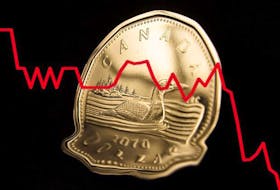The most important measure of the cost of living continues to show that deflation is a bigger threat than runaway prices.
The Consumer Price Index increased 0.1 per cent in August from a year earlier, the second consecutive month the year-over-year change was essentially zero, Statistics Canada reported on Sept. 16. Bay Street was expecting a higher number, so the hot take of analysts was to re-up expectations of low-for-longer interest rates.
“Labour markets are still weak and the economy is still running well below capacity levels, and that should keep underlying inflation trends in check,” said Clare Fan, a Royal Bank of Canada economist.
Canadian industry only operated at about 70-per-cent capacity in the second quarter, down from about 80 per cent in the first quarter and the weakest level since 1987, and the jobless rate is around 10 per cent. The hole created by the COVID-19 recession is huge, which is why Bank of Canada governor Tiff Macklem last week reiterated that the central bank intends to leave borrowing costs very low for an unusually long period of time.
“With CPI inflation close to zero, and downward pressure coming from energy prices, travel services and economic slack more generally, we expect inflation to stay well below the two-per-cent target in the near term,” Macklem said in a speech on Sept. 10. “Our core measures of inflation have drifted slightly lower, consistent with the unused capacity in the economy.”
Core inflation used to be straightforward. The Bank of Canada would remove the most volatile items from the CPI basket and adjust for tax changes to get a read on the trend. But officials decided that approach was too simple. In 2017, the central bank introduced three new gauges to help decide whether it’s on track in guiding the economy to a place that generates annual CPI inflation of around two per cent.
The three measures only make sense to experts, so non-experts have to take the Bank of Canada at its word when it says they are effective predictors of trend. The core rates averaged an annual increase of 1.7 per cent in August, compared with 1.6 per cent the previous month. That suggests deflation probably isn’t a present danger, but that the Bank of Canada is still off target.
“The pandemic has gripped Canada’s economy hard, limiting demand and holding total inflation pressures low,” Arlene Kish, director of Canadian economics at IHS Markit Ltd., said in a note. “A second-wave risk, which some provinces are expecting, and social distance restrictions will keep inflation low in the near term.”
It’s become clear, however, that a significant portion of the public don’t agree with Bay Street’s view.
Carolyn Wilkins, the central bank’s senior deputy governor, acknowledged in a speech on Aug. 26 that “many people feel that inflation is higher than reported” and committed to “dig in more” on the reasons for the disconnect.
Statistics Canada has also heard the complaints. “The CPI, conceptually, is not the easiest measure,” Greg Peterson, the agency’s assistant chief statistician, said in an interview on Sept. 14. “Take a dozen eggs. If I was talking about the CPI for eggs in July as 169.7, that’s not a meaningful number to a lot of people.”
The agency’s approach to inflation is rooted in price theory and follows international norms agreed upon by statistical experts. Still, Peterson conceded, Statistics Canada could “better contextualize the numbers.”
The latest CPI report included a link to a graphic that attempts to explain how experts adjust for changes in quality. For example, when a fancy coffee shop starts serving smaller cups at the same price (CPI goes up), or when your internet company offers faster downloads without changing the price of a bundle (CPI goes down).
Statistics Canada is also working on a digital tool that would allow users to create their own CPI based on their monthly expenditures. Peterson hopes the tool will be ready in October. “Where we need to go is to better contextualize the numbers we are publishing and probably do a better job of trying to relate that to what people are spending,” he said.
People like me can also try harder.
Inflation was a non-story for so long the financial press stopped paying attention. But there are already signs the aftermath of the COVID-19 recession could upend the Bank of Canada’s story. Statistics Canada observed that prices for personal care services surged more than seven per cent from August 2019, as hairdressers passed on the cost of refitting their shops to cope with social-distancing restrictions.
What if that becomes the trend instead of disinflation? “We expect more businesses to start passing additional COVID-19 safety-related costs down to consumers,” said Anna Feng, an economist at the Conference Board of Canada. “This will continue to be a source of upward pressures on prices in the near term.”
A minority view, perhaps, but one to take seriously.
Financial Post
• Email: [email protected] | Twitter: CarmichaelKevin
Copyright Postmedia Network Inc., 2020








